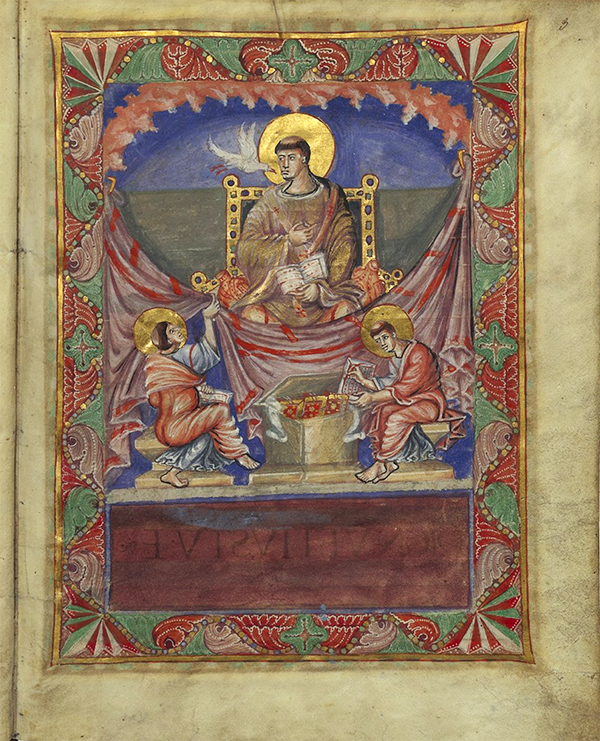Afterlife of Antiquity
Tina Bawden and Karin Gludovatz take a particular interest in illuminated manuscripts, their illustrations and their spatial qualities.
Illuminated manuscripts are a typ ical medium of the middle ages. Usually, books were made from parchment, turning them into long-lasting and prestigious objects. Within the research project (C-4-1) Books and Space in the (early) Middle Ages Tina Bawden and Karin Gludovatz use manuscripts that have been subject to research already as well as less known examples. Fragments of one of the earliest manuscripts, the so called “Quedlinburg Itala” – dating from the 5th century CE – are housed at the National Library in Berlin.
ical medium of the middle ages. Usually, books were made from parchment, turning them into long-lasting and prestigious objects. Within the research project (C-4-1) Books and Space in the (early) Middle Ages Tina Bawden and Karin Gludovatz use manuscripts that have been subject to research already as well as less known examples. Fragments of one of the earliest manuscripts, the so called “Quedlinburg Itala” – dating from the 5th century CE – are housed at the National Library in Berlin.
Karin Gludovatz´ and Tina Bawden´s aim is to analyze connections between the illuminated book and real, imagined and metaphorical spaces. They cover pictorial construction of space in book illumination, the book itself as a spatial construct, and the way in which books as objects determine the perception of their surroundings. The main focus is on book illumination of the early and high middle ages. The project benefits from being situated within a context of research concerned with ancient cultures, offering the possibility of understanding how antique conceptions of space were perceived and transformed in later periods. Carolingian art in particular with its recourse to classical antiquity presents itself as an ideal topic.
The project combines three perspectives on the relationship between books and space. The first topic is the pictorial representation of space in books. Key questions here concern the structuring role of spatial elements for pictorial narration and the relation of pictorial space to the text and its formatting. Further concerns are the relationship between depictions of “natural” spaces such as landscape abbreviations and “artificial” spaces like buildings, as well as their interaction with ornamentation. Visually understanding medieval depictions of space presents some difficulty. Methods of depicting space before the invention of linear perspective around 1420, and the narrative structure of medieval art can both appear unfamiliar to viewers of the 21st century.
The book does not only function as a substrate for images and texts, but it is also an object which creates a space itself, as its use and handling involve movement. This aspect is the second topic Karin and Tina will be looking at. Throughout the middle ages, an understanding of the book in spatial terms is reflected in theological metaphors and in the layout of books. Often, “entrance” and “exit” pages are accorded a specific appearance; paths through the book are drafted, for instance, by constructing spaces which cover several pages, or by leading the gaze through the structure of a page. Unfortunately most of the original book covers have been replaced in the following centuries, but some still exist and therefore will be of particular interest for the scholars.
The third area concerns the spaces in which books perform their function. Key questions concern the relations between the book and the spaces represented in the book, and between books and the spaces in which books are used, for example in ritual contexts and court ceremony. Because of its compact size, the book is predestined to travel through various topographical, temporal and cultural spaces. At the same time the illuminated book always was a prestigious object to which access was limited. Many manuscripts had royal or clerical owners, or were given as a donated to churches or monasteries. They presented a way to of selectively showing images to a privileged audience, a common practice that was highly developed in the early Christian Church.
This project is part of research group (C-4) Pictorial Construction of Space(s) and participates in the Key Topic Mapping and Key Topic Transformation.
RELATED LINKS
Publication: Early Visual Cultures and Panofsky’s Perspektive als ‘symbolische Form’
Research project: (C-4-3) Books and Space in the (Early) Middle Ages
Read more articles in TOPOI FEATURE
CREDITS
Image above: Illuminated manuscript. Pope Gregory I (Folio 3 recto) shown on the Sacramentary of Charlemagne, Carolingian (869-870) | Source: gallica.bnf.fr/Bibliothèque nationale de France, Département des Manuscrits, Latin 1141 | Public Domain
